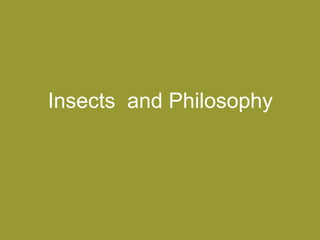
Insects and Philosophy by Richard Dawkins
- 2. Richard Dawkins “ Middle World”
- 3. I squashed an insect yesterday As it ambled up a wall. I couldn’t see its head or legs, It was so very small. It didn’t bite and couldn’t sting, I felt no fear at all.
- 4. We are the champions ………??? We are selfish and arrogant and generally think there are none like us among the billions of stars in the universe As human beings we are happy to kill any other species and murder our own for seemingly trivial reasons. We are also very impatient.
- 5. Are we really superior to insects ? So it is said, but only by humans. I’ve never heard an insect raise the subject. Forget the universe. We both live on this planet and use its facilities as best suits us. A cautious estimate of the number of insect species is about 5 million. Not all have names but the insects don’t give a hoot: a bug by any other name……
- 6. We assess our environment through the same 5 senses: Sight Hearing Touch Smell Taste
- 7. Most insects are sex mad
- 8. Insect Sight Simple eyes and compound eyes: one or both A simple eye is a single lens: tells the difference between light and dark, may also see rough shapes (caterpillars)
- 10. Insect Sight Simple eyes and compound eyes: one or both A simple eye is a single lens: tells the difference between light and dark, may also see rough shapes (caterpillars) A compound eye may have 28000 bits. Movement is seen better than shape. Some can see sharp images and colours. Most insects cannot see red but can see ultraviolet, which we can’t.
- 14. Insect Hearing Insects “hear” through vibrations of air, water or ground. Some insects have hearing organs inside their legs. Some insects hear sounds that people can’t. Crickets detect sound through a “tympanum” like our ear drum. Many moths have one or more and can hear bats’ echo-location.
- 15. Insect sense of taste Detection organs are found mainly on mouths or feet. Bees have them on their antennae. Wasps select where to lay eggs because of the taste organ on their ovipositor. Surgeons have copied the ovipositor of the wood-boring wasp to make a surgical instrument.
- 18. Insect sense of taste We share the same taste sensations: salty, bitter. sweet and sour but insects can also detect particular chemicals. The cabbage butterfly can detect mustard.
- 19. Insect sense of smell Antennae are more “smellers” than “feelers” They help in many ways, such as which way to go Insects cannot detect as many different odours as our noses but can differentiate smells better and sense smaller quantities. A male emperor moth can detect a female six miles away. Social insects (ants,bees) detect unwanted visitors by their smell.
- 20. Insect sense of touch Usually this is felt by the small hairs on the insect, which detect movement when they touch something. These sensory hairs also help honey bees orientate to the earth’s gravity when upside down in the hive. One species of grasshopper can feel air moving at less than 200yards an hour.
- 32. Time
- 36. There are more things in heaven and earth, Horatio, Than are dreamt of in thy philosophy
